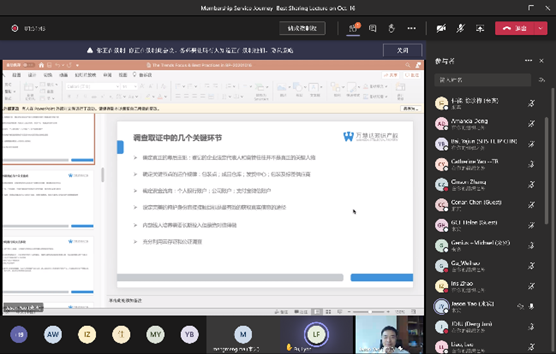On October 16, 2020, an online lecture on Hotspots, Difficulties and Experience Sharing in Brand Protection was successfully held for about 30 representatives from QBPC member companies.
 Mengmeng MaVice Chair of the Membership Services Committee, WHAL
Mengmeng MaVice Chair of the Membership Services Committee, WHAL
Ms. Ma Mengmeng, Vice Chair of the Membership Services Committee, presided over the meeting and thanked the members for actively participating in the Membership Services Journey series and Mr. Jason Yao, the keynote speaker, for his wonderful sharing.

Authorized Representative of LACOSTE, Senior Partner of Beijing Wanhuida Law Firm
Jason Yao, as the authorized representative of LACOSTE in QBPC, is also the senior partner of Beijing Wanhuida Law Firm, where he has been practicing law since 1996 and has long and extensive experience in corporate counsel and intellectual property management. He has been practicing law since 1996 and has long and extensive experience in corporate counsel and intellectual property management, especially in intellectual property management and protection for foreign companies in China, and has participated in handling many difficult and complex intellectual property cases.
He first analyzed the current trend of brand protection: "The production and sales of counterfeit products have become more and more covert and organized, and there is a clear trend of moving underground, inland and Southeast Asia; 'copycat' products such as 'brand name and hitchhiker' products are becoming more and more popular. The brand has become the main form of infringement in the domestic market, in the first and second tier cities in the sub-center and suburban commercial centers, the third and fourth tier cities in the core business district and small towns, all kinds of 'Shanzhai' brand stores and counters compete with each other, a wide variety of; infringement is becoming more and more complex, a variety of nature. Social network marketing and online sales have become the main distribution channels of infringing goods, how to solve the circulation and export of counterfeit goods in the mail channel, and how to identify and stop the sale of infringing goods on social networks and Internet platforms has become the difficulty of brand protection work. With the increase of domestic IP awareness, some local Chinese enterprises are accumulating more and more IP rights, and it will be more and more common for some dishonest enterprises to take advantage of the loopholes in the IP layout of foreign enterprises to make unfair profits."

Under the above mentioned trend of brand protection work, there are some difficulties and pain points in investigation and evidence collection, network monitoring, administrative enforcement, customs protection, criminal prosecution, civil litigation, etc. In response to these issues, Mr. Yao shared several key points, including the key aspects of investigation and evidence collection, the focus of network monitoring, the full use of administrative enforcement, cooperation with public security organs in criminal cases, and the key points of IPR civil litigation.
- Several key aspects of investigation and evidence collection: identifying the real culprits behind the scenes, determining the operation rules of key nodes, determining the flow of funds, making full use of cloud storage and notary investigation.
- Several key areas of focus for network surveillance projects: building a database of network targets; cross-retrieval; online and offline integration.
- How to make full use of administrative enforcement: small-scale and large-scale counterfeiting is the most cost-effective; the acquisition and fixing of key evidence; the importance of rights holders' personal involvement.
- How to make the best use of public security organs in criminal cases: forensics of transaction records through public security investigations; seeking cooperation with public security organs; adequate support from right holders.
- Key points of IPR tort litigation: identification and selection of defendant; selection of jurisdictional court; pre-litigation preparation; application of law and causes of action; timeline for submission of property, evidence and actions; order of submission of evidence, etc.
Representatives from Amazon Kindle Business, Nike, Novozymes, TWE, Unilever and other member companies also exchanged views with the speaker on the protection of intellectual property rights in the field of logistics and express delivery, statutory and punitive damages in civil litigation, and other hot issues.
